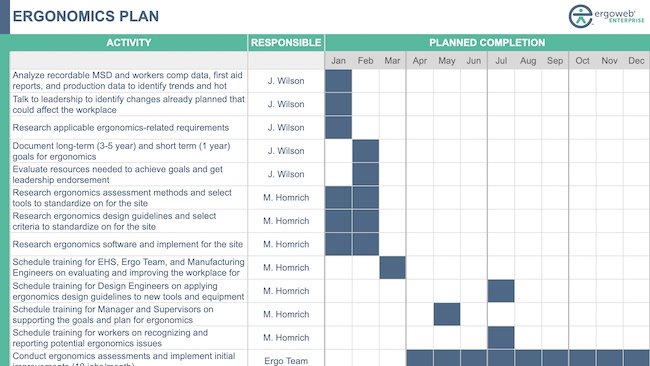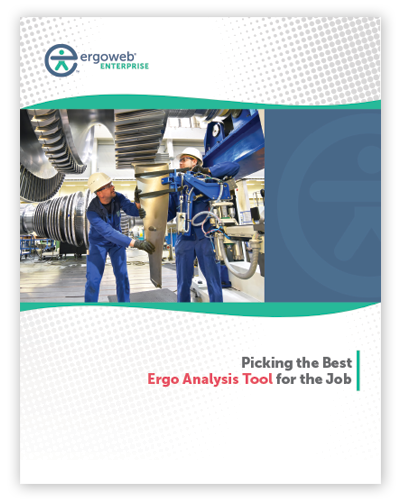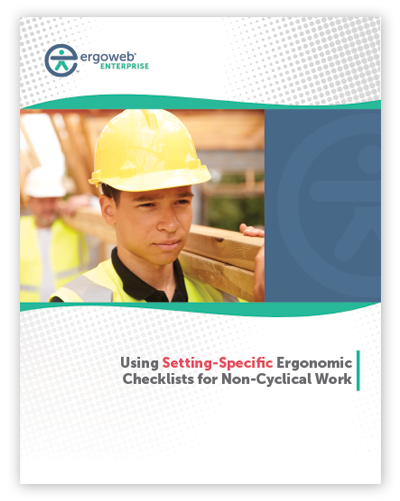Ergoweb® Learning Center
We’ve published and shared thousands of ergonomics articles and resources since 1993. Search by keyword or browse for topics of interest.
Downloadable Guides
Browse Open Access Articles
October 1, 2014
David J. Scalzo joins Ergoweb as CTO. Dave will oversee Ergoweb's technical systems, including our proprietary software systems, web properties and digital media, and internal business processes. He'll also support key Ergoweb partners, including ErgoAdvocate and Ergobuyer.
September 2, 2014
This article presents an intriguing challenge to what has become 'conventional wisdom' with regard to monitor placement. Contributor Gene Kay suggests that the commonly recommended placement of the monitor up near eye-height may actually contribute to eye strain, dry eyes, and neck extension. He suggests the solution is to optimize the monitor position for the visual system, which means placing the monitor lower, positioning it closer to the "normal reading position" that has worked well for thousands of years.
July 29, 2014
German researchers investigated the effects of seated work vs. a mix of seated and standing work on physical and psychological complaints and on data entry performance. They found improvements in musculoskeletal comfort and mood when subjects varied working postures between sitting and standing, as compared to sitting only, with small effects on data entry performance.
July 8, 2014
The upright seated posture is commonly thought to be the best posture for computer work, but this view is not well supported by ergonomics science. This article explores the conventional wisdom of sitting and presents current ergonomics thinking about one of the most persistent topics in office ergonomics.
June 3, 2014
Delivering comprehensive ergonomics services to large or distributed office populations is challenging, time consuming and very expensive. Sending qualified ergonomics professionals is often difficult to arrange, […]
May 13, 2014
Researcher Jim R. Potvin has proposed an equation that could have significant impact on the way ergonomists estimate risk for repetitive tasks. Potvin performed a meta-analysis of various psychophysical studies (e.g., Snook et al) that looked at the maximum acceptable efforts for a variety of tasks. He found that Duty Cycle, essentially the percentage of a job cycle that force or torque is exerted, can be used to predict maximum acceptable force and torque efforts.
April 16, 2014
Ergoweb's Peter Budnick details his views on the emerging debates surrounding the relationships between ergonomics, a field he believes is fairly well defined, and wellness, a concept that is not well defined, though intuitively appealing. "Ergonomics and wellness complement each other, but they are not one and the same," he concludes.
April 2, 2014
Anthropometry is a primary consideration in ergonomics, yet is often misunderstood and misapplied in the design of equipment and systems. In this example of why ergonomics is not always "common sense," guest contributor Bruce Bradtmiller, a leading anthropometry expert, explains why it's important to understand the complexity of anthropometry, and provides an explanation of one technique called multivariate accommodation modeling (MAM) using principal component analysis (PCA). Sound complicated? Bradtmiller cuts through the complexity and provides a simplified understanding that will make you appreciate anthropometry in a new way next time you sit in a chair or glance into the cockpit of an airplane as you board. Creating a good fit is not as easy as some might think.
March 4, 2014
We previously published an article titled "Is There An Industry Standard For Desk Height?" in which we questioned the often suggested "industry standard" of 29 inches for office workers, "which ergonomists know can't possibly be right for all people." In this article, Peter Budnick reviews the origin of the 29 inch dimension in greater detail and makes the call for ergonomists to educate, inform and help the office environment move beyond such one-size-fits-all thinking, especially when one size never fits all.






